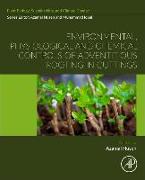Environmental, Physiological and Chemical Controls of Adventitious Rooting in Cuttings
BücherAngebote / Angebote:
The goal of this book is to provide a review, as thorough and up-to-date as possible, of the state-of-the-art of the environmental, physiological and chemical controls of adventitious rooting in cuttings obtained from plants. In plants, adventitious roots, which are highly useful for vegetative propagation (or clonal propagation) are produced mainly from leaves, hypocotyls, stems or shoots. Vegetative propagation may occur naturally by making use of propagules such as roots, underground and aerial stems, leaves, buds and bulbils. It may also be done artificially through regenerative organs (rhizomes, bulbs, and corms) and by utilizing specialized methods, like cutting, grafting and layering. The technique of stem cuttings has long been used as an effective and economical method/measure of clonal propagation of uniform and pathogen-free plants of elite genotypes/germplasms. This is particularly true for various species of horticultural and forestry value. The technique is of special importance for plants producing seeds that are highly recalcitrant and have a very low germination percentage. Quite often, both in vitro and in vivo clonal propagations are carried out using different types of explants. For in vitro clonal propagation usually axillary buds in the nodal segments are used, while various types of stem cuttings are chosen for in vivo propagation. Adventitious root formation in cuttings is a crucial physiological process for clonal propagation of many plant species. Overall, a plethora of factors affect the adventitious rooting of cuttings, adding to the complexity of the phenomenon. The main factors which control adventitious root formation are types of cuttings, presence of leaf area on cuttings, types of hormones and their concentration, duration of hormonal treatment (quick dip, long soak, dry dip, spray dip, or total immerse method), maturation (juvenile or mature), genotype, explant position (basal, middle or apical cuttings), irradiance, temperature, water availability, season, mineral nutrition, rooting conditions, and/or proliferation medium. The identification and the use of correct combination and/or hormonal or auxin treatments have improved the rooting potential even in hard-to-root species. It has been noticed that in spite of a thorough control of environmental factors in the modern propagation industry, high economic losses still occur because of insufficient rooting. Therefore, understanding of each aspect associated with the adventitious root formation in cuttings is important and remains a fertile discipline for research. Pretreatment of cuttings with auxins such as indole-3-acetic acid, indole-3-butyric acid and a-naphthalene acetic acid causes metabolic changes during the adventitious root formation, which consists of three successive but independent phases, namely induction, initiation, and expression. The induction phase comprises of molecular and biochemical events without visible changes, the initiation phase is characterized by cell divisions and root primordia organization, and the expression phase denotes the intra-stem growth of root primordia and the emergence of roots. Since rooting is a high-energy-demanding process, rooting ability of cuttings has been frequently discussed in relation to soluble and storage carbohydrate contents. Availability of energy sources as well as supply of nitrogen and amino-acid affects the pace and intensity of adventitious root formation. Furthermore, significant alterations in enzyme activities and metabolite accumulation observed in plant cuttings suggest that the activity of specific enzymes and metabolites governs the adventitious root formation. For instance, oxidative enzymes, widely distributed in higher plants, have special significance during the rooting. In many studies, changes in the pattern of oxidative enzymes such as peroxidase, indole acetic acid oxidase, etc, have been taken as the biochemical markers for the successive rooting phases. Further, cutting-edge tools of genome and proteome analysis have been used to understand molecular regulations, gene actions, and cellular processes involved in adventitious root formation. Several candidate genes have been identified to provoke the induction, initiation, and maintenance of adventitious root primordia-associated signaling cascading network. Considering these crucial points, it becomes essential to understand the underlying factors and their interactions during the formation of adventitious roots in cuttings. Given the above, effort has been made in the present book to cover a wide range of topics, as mentioned above, and discuss the environmental, physiological, and chemical controls of adventitious rooting in cuttings. The authors have crafted each chapter with immense clarity, reviewing up-to-date literature and presenting lucid illustrations.
Folgt in ca. 15 Arbeitstagen




